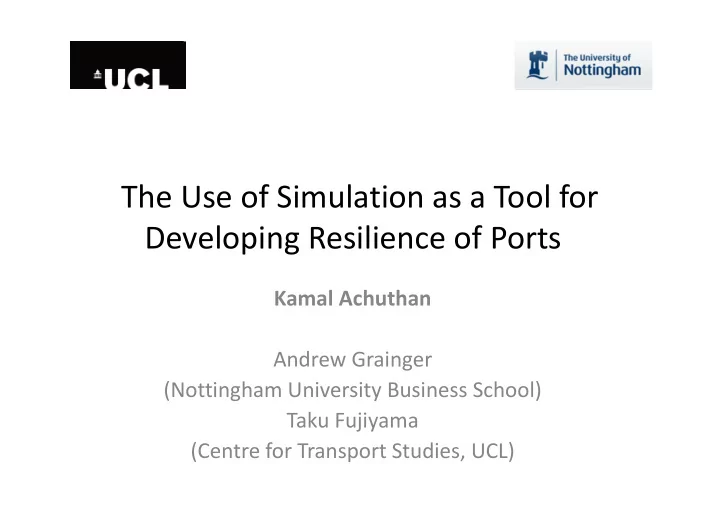

The Use of Simulation as a Tool for Developing Resilience of Ports Kamal Achuthan Andrew Grainger (Nottingham University Business School) Taku Fujiyama (Centre for Transport Studies, UCL)
Why ports need to be resilient? • Ports are critical nodes in the global supply chain – UK being an island, ports are considered as a critical national infrastructure • More than 90% of world trade involves shipping and port facilitates the transfer of goods from sea to land • Disruptions can cause large fluctuations in global supply chain (economic loss and impacts to society) • Supply chain system relies on resilience of ports – UK DEFRA food security report (90% food is through ports) • Individual ports are getting specialized in their services – Location, Handling of vessels and goods, capacity IMA Seminar 23Oct2012 2
Resilience • Many definitions – Ability of the system to bounce back after a shock and return back to its normal service levels – Capability of the system to provide and maintain an acceptable level of service during disruption • Prevention, Response & Recovery • Resilience requires strategies to be in place for managing risks that have not been identified IMA Seminar 23Oct2012 3
Resilience Period of disruption Threat Loss in Capacity / capacity Performance measure Response Recovery Time IMA Seminar 23Oct2012 4
Problem • Ports are vulnerable to threats – Natural disasters, human factors, organizational factors and infrastructure failures • Complex system with wide range of stakeholders • Interdependencies – Unbounded Risks – Requires a system wide risk management • Impacts – Failures that cascade from delays to a complete closure IMA Seminar 23Oct2012 5
Project • Aims to gain an understanding of risk and resilience within UK’s ports • In a port environment – Study & understand interdependencies and associated unbounded risks and how it affects resilience – A simulation model that represent risk dependencies across the system and helps assess/ improve system wide resilience IMA Seminar 23Oct2012 6
Case study - Port of London(PoL) • UK’s second largest port – 2010 ~ 48 million tonnes – Serves critical supplies to South East England • 80 terminals stretch along tidal Thames – Tilbury, Tate & Lyle, CORYTON & London Gateway • Port of London Authority – Public & Private stakeholders • Fragmented and complex interdependencies IMA Seminar 23Oct2012 7
Methodology System mapping Interdependency Resilience analysis assessment • Stakeholders • Dependencies • Simulation model • Processes • Threats • System • Resources • Vulnerabilities impacts • Scenario exercise IMA Seminar 23Oct2012 8
System Mapping Environment Port Facilities IMA Seminar 23Oct2012 9
Interdependencies Environment Port Facilities IMA Seminar 23Oct2012 10
Interdependency analysis IMA Seminar 23Oct2012 11
Simulation model • Purpose is to measure the impact of a threat scenario on port performance (throughput, delays etc.) – Visual verification and interaction – Response/recovery measures could be tested • Port operations simulation model – Specific for PoL to capture the physical, operational and management complexities – Focus on sea-side operations • Discrete Event Simulation using AnyLogic IMA Seminar 23Oct2012 12
Simulation model Flow of ships/goods (- Loss of Throughput) Flow of ships/goods (Throughput) Environment Port Facilities Time Time(+ delay/disruptions) IMA Seminar 23Oct2012 13
Outputs • Resilience metrics (Before, during & after a disruption scenario) – Ship turn around time – Number of ships served (by resource) • Tonnage, goods type ->£££ – Queues/delays • Loss, utilization • Perform analysis to identify critical variables IMA Seminar 23Oct2012 14
Resilience Assessment IMA Seminar 23Oct2012 15
Scenario based exercise (Involving stakeholders) • Brings stakeholders together and understand individual/ system risks due to dependencies Identify/understand critical links • with stakeholders Response/resilience strategies • could be worked out in co- operation • Set up resilience forums, support each other during crisis & joint investments on resilience IMA Seminar 23Oct2012 16
Conclusions • Ports need to be resilient – Requires system wide understanding of the complex interdependencies and the associated unbounded risks • A methodology to assess and improve resilience of port system proposed – The simulation model representing interdependencies will help assess resilience – The resilience assessment using stakeholder participation will help improve resilience • Help port stakeholders – More accurately evaluate risk management procedures and practices – Develop port-wide business continuity plans – Optimize the allocation of resources IMA Seminar 23Oct2012 17
Thank you Kamal Achuthan k.achuthan@ucl.ac.uk
Recommend
More recommend